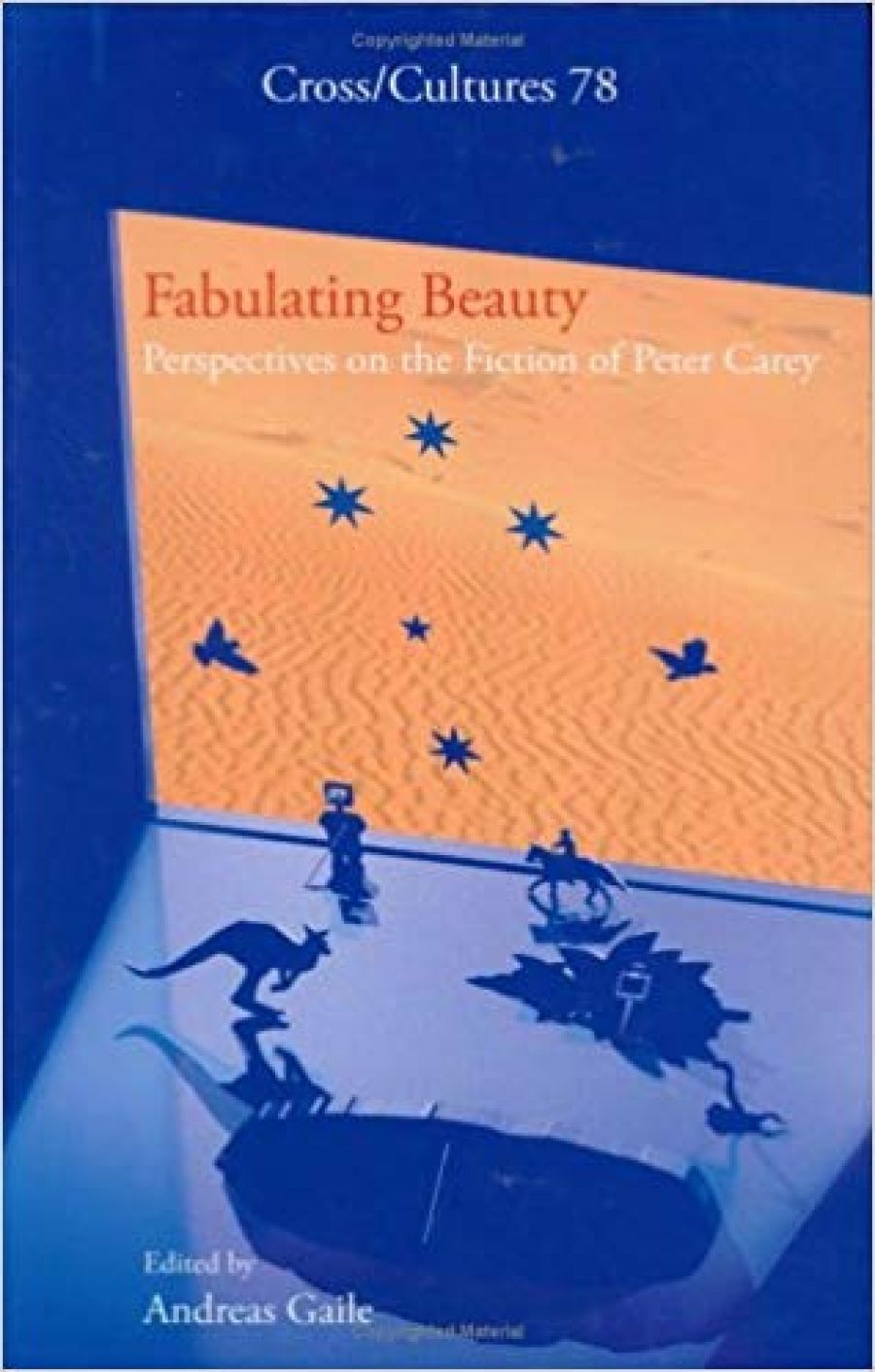
- Free Article: No
- Contents Category: Literary Studies
- Review Article: Yes
- Online Only: No
- Custom Highlight Text:
In the last essay in this collection, Robert Macfarlane touches on the main reasons why Peter Carey’s novels ‘have proved so very attractive to academic exegetes’, in their combination of the postmodern and the postcolonial. Just how attractive is demonstrated in the sixty-page bibliography, which is sure to be one of the most used parts of Fabulating Beauty, especially by overseas readers without access to the invaluable AustLit. Editor Andreas Gaile, a young German academic, notes in his introduction that Carey is now ‘the most widely commented-on living Australian author’. While Patrick White is currently well ahead, with more than twice as many critical items published on his work, Carey is catching up fast. Visit any bookshop, whether in Melbourne, London, or New York, and you will of course find many more titles by Carey than by White. If, as Simon During has argued, White was the perfect novelist for those wishing to argue for the academic significance of Australian literature in the 1950s and 1960s, then Carey has just as obviously caught the dominant theoretical currents of the past thirty years. While Tim Winton may sell just as well and, if ‘favourite book’ polls are any guide, be more loved, no one has yet published a major critical study of his work.
- Book 1 Title: Fabulating Beauty
- Book 1 Subtitle: Perspectives on the fiction of Peter Carey
- Book 1 Biblio: Rodopi, US$119 hb, 473 pp, 9042019565
As the bibliography demonstrates, no less than seven monographs have so far appeared on Carey’s work, mainly published in Australia but also in Italy, Austria, and Britain. Doctoral theses have been completed in Ireland, France, Sweden, Germany, and Canada, as well as Australia. The international interest reflected here is also seen in the twenty essays collected in Fabulating Beauty, only five of which have previously been published. Nine are by Australian academics, five by Germans, three by Americans, along with two by critics from Britain, and one from Sweden. Gaile also provides a new interview with Carey, who must be the most frequently interviewed of any Australian author.
Most of the essays focus on particular works, though Karen Lamb provides an insightful piece on Carey’s reputation since winning his second Booker Prize for True History of the Kelly Gang (2000). Unlike some of the other critics here, whose readings of Carey seem too simplistically postcolonial, Lamb notes the ‘increasingly imperialist appro- priation of his work’ following his first Booker win with Oscar and Lucinda (1988), his attempts to resist this with the less well-received The Tax Inspector (1991) and The Unusual Life of Tristan Smith (1994), but then his retreat to the safety of the past with Jack Maggs (1997) and True History.
Interestingly, there is no essay here specifically on The Tax Inspector, even though, as one contributor notes, this is probably Carey’s most puzzling novel. All other titles get individual treatment, including his one book for children, The Big Bazoohley (1995), and his travel book 30 Days in Sydney (2001). (The more recent Wrong about Japan, 2004, is listed in the bibliography but clearly appeared too late to be discussed.) There is only one essay on Tristan Smith, as compared with two on each of Carey’s Booker Prize winners, and no less than three on Jack Maggs, suggesting that academics are just as influenced by awards as is the ordinary punter.
Given the volume of criticism that has already appeared on Carey’s fiction, the essays in Fabulating Beauty, which rely mainly on postcolonial and/or postmodernist approaches, often seemed to have little new to say. For me, the most interesting were those that succeeded in placing Carey’s works in larger literary or historical contexts. So Nicholas Birns sets his reading of the early story ‘Kristu-Du’ within a survey of the political realities of the 1970s, demonstrating how closely these are reflected in Carey’s supposedly ‘fantastic’ fiction. Bruce Woodcock provides an equally engaging reading of Jack Maggs against Karl Marx’s Capital, reminding us that, as a best-selling international novelist, Carey is inevitably incorporated within the capitalist system he has so often critiqued as much as he is within old and new imperialisms. Susan K. Martin echoes this point in her study of True History within the context of earlier Australian fiction about Ned Kelly, noting the difficulty of distinguishing between ‘the critique of commodification and enthusiastic contribution to it’, something that has concerned me about Carey’s fictional treatment of Australia ever since Illywacker (1985). Martin also draws attention to the insistence on Kelly’s heterosexuality, not only in True History but in Robert Drewe’s earlier Our Sunshine (1991), not to mention the recent film, all of which provide Kelly with a fictional female lover, with Carey also adding a daughter. This, she argues, serves to reinforce Kelly’s position as the archetypal Australian hero: white and unambiguously masculine.
In contrast, Robert Macfarlane reads My Life As a Fake (2003) against a number of recent English novels that have also been concerned with the question of authenticity, especially in relation to the literary, by writers such as Peter Ackroyd, A.S. Byatt, and Julian Barnes. He notes that all, like Carey, have difficulty with ‘how to take on these literary-theoretical questions of authenticity and re-cast them valuably in a fictional form without squeezing the human air out of a novel’.
While contemporary novelists’ preoccupation with such theoretical questions has proved very attractive to academics, the accompanying loss of ‘human air’ seems to have been one of the reasons for literary fiction’s declining general readership. And, as Fabulating Beauty shows, postcolonial and other post-structuralist approaches usually work best when applied to texts from a more innocent age. If the novelist is as theoretically sophisticated as the critic, comparative and contextual readings can offer more insight.


Comments powered by CComment